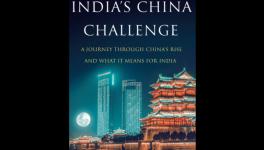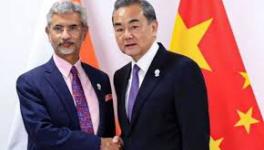Galwan Valley Clash: Where do India and China Go from Here?

Image Courtesy: PTI
Strategic experts on India and China are preoccupied with debating the implications and consequences of the 15 June military clash between the two countries on the Line of Actual Control (LAC) at Galwan Valley in eastern Ladakh.
However, the key issues that affect border peace between India and China, and call for fulsome debate among interested scholars, are, first, the nature of the border dispute between the two countries; and second, the future of peaceful co-existence between two largest nuclear-armed Asian neighbours. The strategic experts seemingly bypass these issues as if they do not matter and only strategy matters.
The positive nature of the dialogue between President Xi Jinping and Prime Minister Narendra Modi at their Informal Summits in 2018 and 2019 needs to be saved from national chauvinism and jingoism and pursued with renewed vigour and confidence. War between the two countries will only be of interest to external vested interests, as has happened in the past.
The loss of life of Indian soldiers in the 15 June clash at Galwan Valley also needs examination. Mutually-conflicting claims underline the need for proper delimitation and determination of the LAC, an issue that is pending since long. A book has been written on the way in which Myanmar and China settled their border question. Compromise and give-and-take are needed when resolving great matters of moment. India should avoid the “self-righteous intransigence” unfortunately displayed by Jawaharlal Nehru and courageously pursue the path of peace negotiations with China. We could learn from the Myanmar-China experience.
India and China can and should live in peace as friendly neighbours as they have done historically.
Motivated third-party intervention has only meant trouble.
A key conflict-promoting event in the recent period has been the annulment in December 2019 by India of the autonomous status of the state of Jammu and Kashmir and the setting up in its place of the two Union Territories of J&K and Ladakh. The Ladakh region is subject to conflicting claims from India, China and Pakistan on the Aksai Chin and Gilgit-Baltistan regions. Settlement of the border depends on the peaceful settlement of these rival claims. India needs to accept the existence of these conflicting interests and seek to evolve a compromise formula to settle rival claims rather than trying to pre-empt them.
War is not a pragmatic option, as pointed out by Sudheendra Kulkarni below.
Four Key Writers
The views of the four important writers examined below are relevant in arriving at a balanced judgment on India’s border dispute with China. These are the journalist Sudheendra Kulkarni; BR Deepak, the historian; Neville Maxwell, the political analyst and Dev Lewis, the technological whizz-kid.
Sudheendra Kulkarni:
In a well-argued opinion in the Indian Express on 19 June, Kulkarni argues that the “LAC has little meaning and India-China should reimagine the contours of a new Boundary of Assured Control.”
Kulkarni goes on: For Modi the choice is stark. He should not repeat Nehru’s blunder, risk an unwinnable war with China and end his premiership without solving the India-China boundary dispute. The two countries must harmonise their territorial claims through mutual consensus. A chance to do so arose in 1960, when the Chinese Premier Zhou Enlai visited India with a “package deal” to exchange India’s recognition of Chinese control of Aksai Chin in the West and Chinese recognition of India’s control over Arunachal Pradesh in the East. The proposal was rejected by Nehru who faced strident opposition. The result was the 1962 war.
Till 1954, Aksai Chin had remained “undefined territory” in British records.
If Nehru had accepted Zhou Enlai’s package deal, a permanent settlement of the border was possible; a war prevented; no face-offs along a disputed LAC; and even perhaps China’s recognition of India’s claim over the constitutional status of J&K.
India cannot militarily drive China out of Aksai Chin. Modi must show courage, ignore military help from the United States and convince the opposition in Parliament and the public to strike a compromise-dependant solution of the boundary dispute with China and convert the Line of Actual Control (LAC) into a Boundary of Assured Control (BAC).
Historian BR Deepak
On 11 July, the author wrote in the Sunday Guardian, New Delhi that India’s myopic China policy needs to change.
One, it must acknowledge the reality of China’s rise, the asymmetries in the relationship, the dynamics of global and regional balance of power and major power relations. India needs to note what is workable and achievable and what is not, and reshape its engagement with China on the basis of “pragmatic constructivism”.
Foreign policy and military affairs are not to be hijacked by sporadic outbursts of national sentiments; they need to be goal-oriented, long-term and sustainable. There is no room for cosmetic changes, knee-jerk reactions, lip service and lopsided approaches.
Two, China has never treated India as an equal in its modern and contemporary history. The regional balance is clearly tilted in China’s favour. India cannot expect China to relent on issues such as NSG, UNSC and on the border. It is futile for India to ask for recasting the LAC; China is not interested in defining it. The imposition of “buffer zones” along the points of friction suits China’s long-term strategy to demilitarise the LAC on its terms.
To challenge the established hegemon (the United States), China emits signals to other countries in the region and beyond. Thus, it has announced the arrival of G2 (the United States and China) and forced nations to choose between them, [which is] perhaps a strategic miscalculation. China today is willing to lead the South, drive a wedge between the United States and its allies in the North, and browbeat those who are perceived as threats to the Chinese order, though says it doesn’t want to alter the liberal global order that has worked in its favour so far.
Three, since China’s pivot to Asia is here to stay and it will further undermine India’s place and role in the region. India’s policy calibration should be to shift its focus from Pakistan to China. Pakistan’s asymmetries with India are far greater than India’s with China’s; India’s GDP alone is over ten times that of Pakistan. India’s LAC with China is almost five times longer than its LoC with Pakistan. Why focus only on Pakistan for a few myopic electoral gains? India should ignore Pakistan if it wants to be a great power. India plays by China’s play-book by getting bogged down in a conflict situation with Pakistan.
Four, total decoupling from China is impossible. India must formulate a pragmatic trade and investment policy, which has so far been haphazard, directionless and extremely muddled. To talk about erecting a great wall against Chinese tech companies, cancelling Chinese contracts and banning their participation in our business activities will be useless. Chinese inroads into India’s telecom sector started right after India’s nuclear explosions in 1998.
In 2009-10, India failed to restrict Chinese telecom companies from selling telecom gears to India’s service providers because of security threats though when their executives met the officials from the Prime Minister’s Office, home ministry, communications ministry and the National Security Council, things suddenly became normal. A few years down the line, most of Chinese FDI was directed towards the Digital India campaign. India’s back-office-of-the-world tag disappeared from public discourse all of a sudden. Rather than developing our own apps and related platforms, India was flooded with Chinese apps, smartly on Chinese smartphones and e-commerce portals. India must identify sectors where pragmatic cooperation with China could be realised.
Five, India’s, security cooperation with the United States, its participation in the Indo-Pacific strategy, and the Quad are seen by China as an attempt at its containment. Security must be accompanied by solid economic engagement, which at the bilateral level may be possible in certain areas, but could be a challenge at the multilateral level. The security budget allocated by the United States to Indo-Pacific is an abysmal 0.3% of its total military expenditure for the next one year. India has no Indo-Pacific strategy in its foreign policy and its economic, military and diplomatic engagement in the Indo-Pacific remains very low.
Finally, India’s economic growth and its capacities to handle domestic and external challenges will enable it to seek an understanding from China along India’s borders and in its regional and global aspirations. As long as India’s growth trajectory remains weak, its social cohesion and communal harmony in disarray, it cannot achieve recognition from global players.
Political analyst Neville Maxwell:
Maxwell says that in 1986 Gorbachev in a seminal speech at Vladivostok, made clear that the USSR accepted the Chinese approach to border disputes between the two countries, after earlier having accused Beijing of aggressive expansionism. Maxwell, in this presentation, advocates the Russian approach to the border dispute between India and China. See the section on “How to Settle the Sino-Indian Borders” in the first part of his book China’s Borders: Settlements and Conflicts, which, from page 171 reproduces his article published in the July-September 2000 issue of World Affairs.
Tech Whiz Dev Lewis:
Lewis is a fellow at the Digital Asia Hub and Yenching Scholar at Peking University. #ChinaIndia Networked, a newsletter published by him, explores the networked relationship between the two regions “at the intersection of technology, society and politics”.
Lewis explores the implications of India’s blocking, on 29 June, of 59 Chinese apps including TikTok and WeChat, which is the only communication channels between India and China. This is a China policy that brings more pain than gain. The policy pulls the plug on a promising technical partnership that was a new domain for China-India exchange and learning (see also Payal Arora). The walling out of TikTok in effect censures its 200 million Indian users and prevents them from participating in the global media information space.
He also notes that the WeChat ban closes the only communication channel between Chinese and Indian people. This is an example of a paternalistic state removing agency to prevent individuals from defining what is good for them. This turns the clock back on people to people engagement.
The is an independent scholar and a former civil servant. The views are personal.
Get the latest reports & analysis with people's perspective on Protests, movements & deep analytical videos, discussions of the current affairs in your Telegram app. Subscribe to NewsClick's Telegram channel & get Real-Time updates on stories, as they get published on our website.
























